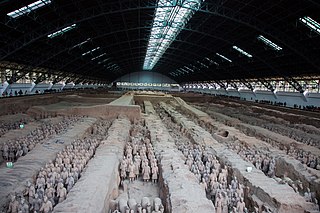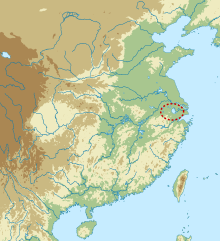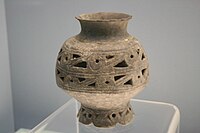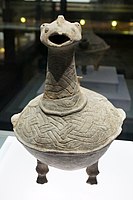
The Terracotta Army is a collection of terracotta sculptures depicting the armies of Qin Shi Huang, the first emperor of China. It is a form of funerary art buried with the emperor in 210–209 BCE with the purpose of protecting him in his afterlife.

Songjiang is a suburban district of Shanghai. It has a land area of 605.64 km2 (233.84 sq mi) and a population of 1,909,713 (2020). Owing to a long history, Songjiang is known as the cultural root of Shanghai.

The Yangshao culture was a Neolithic culture that existed extensively along the middle reaches of the Yellow River in China from around 5000 BC to 3000 BC. The culture is named after the Yangshao site, the first excavated site of this culture, which was discovered in 1921 in Yangshao town, Mianchi County, Sanmenxia, western Henan Province by the Swedish geologist Johan Gunnar Andersson (1874–1960). The culture flourished mainly in the provinces of Henan, Shaanxi and Shanxi.

Yue, also known as Yuyue (于越), was a state in ancient China which existed during the first millennium BC – the Spring and Autumn and Warring States periods of China's Zhou dynasty – in the modern provinces of Zhejiang, Shanghai and Jiangsu. Its original capital was Kuaiji ; after its conquest of Wu, Yue relocated its court north to the city of Wu. Yue was conquered by Chu in 306 BC.

Jinsha is a Chinese archaeological site located in the Qingyang District of Chengdu, the capital of China's Sichuan Province. Along with Sanxingdui, the site is the first major discovery in China during the 21st century. It is listed on the UNESCO World Cultural Heritage Tentative List and Major Sites Protected at the National Level. The Chinese Internet Information Centre ranked Jinsha 5th on the Top 10 Archaeological Discoveries in 2001.

The Dawenkou culture was a Chinese Neolithic culture primarily located in the eastern province of Shandong, but also appearing in Anhui, Henan and Jiangsu. The culture existed from 4300 to 2600 BC, and co-existed with the Yangshao culture. Turquoise, jade and ivory artefacts are commonly found at Dawenkou sites. The earliest examples of alligator drums appear at Dawenkou sites. Neolithic signs, perhaps related to subsequent scripts, such as those of the Shang dynasty, have been found on Dawenkou pottery. Additionally, the Dawenkou practiced dental ablation and cranial deformation, practices that disappeared in China by the Chinese Bronze Age.

The Hemudu culture was a Neolithic culture that flourished just south of the Hangzhou Bay in Jiangnan in modern Yuyao, Zhejiang, China. The culture may be divided into early and late phases, before and after 4000 BC respectively. The site at Hemudu, 22 km northwest of Ningbo, was discovered in 1973. Hemudu sites were also discovered at Tianluoshan in Yuyao city, and on the islands of Zhoushan. Hemudu are said to have differed physically from inhabitants of the Yellow River sites to the north. Some authors propose that the Hemudu Culture was a source of the pre-Austronesian cultures.

The Majiabang culture, formerly also written Ma-chia-pang, was a Chinese Neolithic culture that occupied the Yangtze River Delta, primarily around Lake Tai west of modern Shanghai and north of Hangzhou Bay. The culture spread throughout southern Jiangsu and Zhejiang north of Hangzhou Bay from around 5000 BC to 3300 BC, coexisting with the Hemudu culture in Zhejiang south of the bay. The later part of the period is now considered a separate cultural phase, referred to as the Songze culture. The Majiabang and Songze cultures were succeeded in their area by the Liangzhu culture.

Banpo is an archaeological site discovered in 1953 by Shi Xingbang, and located in the Yellow River Valley just east of Xi'an, China. It contains the remains of several well organized Neolithic settlements, like Jiangzhai, carbon dated to 6700–5600 years ago. The area of 5 to 6 hectares is surrounded by a ditch, probably a defensive moat, 5 to 6 meters wide. The houses were circular, built of mud and wood with overhanging thatched roofs. They sat on low foundations. There appear to be communal burial areas.

The history of Shanghai spans over a thousand years and closely parallels the development of modern China. Originally a small agricultural village, Shanghai developed during the late Qing dynasty (1644–1912) as one of China's principal trading ports. Although nominally part of China, in practice foreign diplomats controlled the city under the policy of extraterritoriality. Since the economic reforms of the early 1990s the city has burgeoned to become one of Asia's major financial centers and the world's busiest container port.
Beginning in the latter half of the 20th century, artifacts bearing markings dating to the Neolithic period have been unearthed at several archeological sites in China, mostly in the Yellow River valley. These symbols have been compared to the oracle bone script—the earliest known forms of Chinese characters, first attested c. 1200 BCE—and have been cited by some as evidence that Chinese writing has existed in some form for over six millennia. However, the Neolithic symbols have only been found in small numbers, and do not appear to go beyond pictorial techniques, as is required to obtain a true writing system representing spoken language.

Sinauli is an archaeological site in western Uttar Pradesh, India, at the Ganga-Yamuna Doab. The site gained attention for its Bronze Age solid-disk wheel carts, found in 2018, which were interpreted by some as horse-pulled "chariots".
The Dapenkeng culture was an early Neolithic culture that appeared in northern Taiwan between 4000 and 3000 BC and quickly spread around the coast of the island, as well as the Penghu islands to the west. Most scholars believe this culture was brought across the Taiwan Strait by the ancestors of today's Taiwanese aborigines, speaking early Austronesian languages. No ancestral culture on the mainland has been identified, but a number of shared features suggest ongoing contacts.

Tell Yunatsite, also known as Ploskata mogila, is situated in the Pazardzhik Province of southern Bulgaria, some 8 kilometres (5 mi) to the west of the district capital Pazardzhik. The tell stands 12 metres (39 ft) above modern ground level and has a diameter of 110 m (360 ft). It is situated on a low terrace at the right bank of the former Topolnitsa riverbed near to its confluence with the Maritsa River. Medieval, Roman, Iron Age, Early Bronze Age, and Copper Age periods have all been attested at the site. The Copper Age tell is associated with the Karanovo culture.

Sohr Damb, c. 3800–2300 BC, is an archaeological site, located near Nal, in central Balochistan, Pakistan that begins before the Indus Valley civilization featuring Togau, Kili Ghul Mohammad, and Kechi Beg pottery styles. It has also been known as Naal, Balochistan, and gave its name to the prehistoric Amri-Nal culture, which is attributed to the dual typesites of Amri and Nal.
Xituanshan is a Late Bronze Age group of stone burials in Jilin, China. It was designated a Major National Historical and Cultural Site by the Chinese government in 2001.
Tel Mevorakh is a small mound situated on the southern bank of Nahal Taninim in Israel. The tel does not exceed 1 dunam but rises to a height of 15 metres (50 ft) above its surrounding plain. The site contains some fifteen layers of human settlement, which accumulate to a height of 8 meters, meaning the natural hill does not exceed a height of 7 meters. It is located on the border between the wide Sharon Plain and the coast of Mount Carmel.

Zhongli was an ancient Chinese state in the Huai River valley during the Spring and Autumn period. Its core area was located in the modern-day Fengyang County. At its peak, Zhongli was powerful enough to fight off various other states, and served as an important cultural, political, and economic centre. The state was conquered by its expansionist neighbor Chu during the 6th century BC, but its former capital city remained regionally important for several subsequent centuries.
The Fisher Mound Group is a group of burial mounds with an associated village site located on the DesPlaines River near its convergence with the Kankakee River where they combine to form the Illinois River, in Will County, Illinois, about 60 miles southwest of Chicago. It is a multi-component stratified site representing several Prehistoric Upper Mississippian occupations as well as minor Late Woodland and Early Historic components.

Majiayuan (Ch:马家垸遗址) is an 3rd-2nd century BCE archaeological site in Gansu, China. The site is considered as belonging to rulers of the culture of the Xirong, recently subjugated by the state of Qin, who included them within the defensive wall of King Zhao of Qin, built in 271 BCE. It is rather similar to another Xirong site about 50 km away, the Wangjiawa cemetery (王家洼墓地). Majiayuan was a zone of interraction between the Chinese and their nomadic neighbours to the west and north during the Warring States period.




















